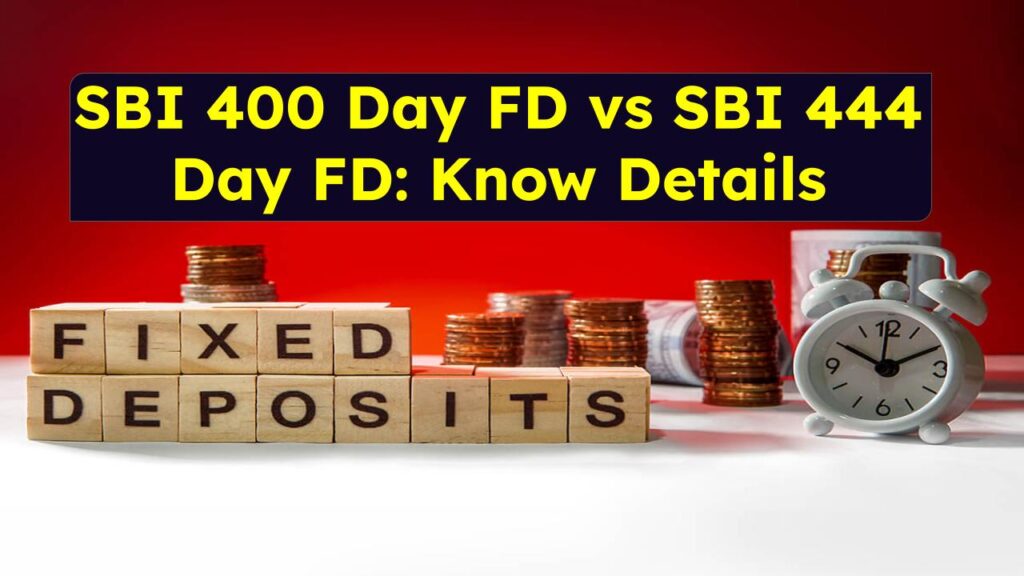
When it comes to investing your hard-earned money, choosing the right fixed deposit (FD) scheme is crucial. Among the leading options in India, SBI’s 400-day FD and SBI’s 444-day FD are two popular choices. Both offer attractive interest rates, safety, and flexibility.
SBI 400 Day FD vs SBI 444 Day FD
| Feature | SBI 400-Day FD | SBI 444-Day FD |
|---|---|---|
| Tenure | 400 days | 444 days |
| Interest Rate (General) | 7.10% | 7.25% |
| Interest Rate (Senior) | N/A | 7.75% |
| Maturity Amount Example | Rs 4,31,080 for Rs 4 lakh investment | Rs 4,39,148 for Rs 4 lakh investment |
| Best For | Shorter tenure with decent returns | Higher returns, especially for seniors |
Choosing between the SBI 400-Day FD and the SBI 444-Day FD boils down to your financial needs and priorities. While the 400-day FD offers quicker access to funds, the 444-day FD delivers superior returns, especially for senior citizens. By carefully evaluating factors like tenure, interest rates, and personal goals, you can pick the option that aligns best with your aspirations.
What Are Fixed Deposits (FDs)?
Before diving into specifics, let’s understand what a Fixed Deposit (FD) is. An FD is a type of savings account offered by banks where you deposit a lump sum amount for a fixed period at a predetermined interest rate. The key advantage is that your money grows steadily over time, and FDs are considered one of the safest investment options in India.
For instance, if you invest Rs 1 lakh in an FD with an annual interest rate of 7%, after one year, you’ll earn Rs 7,000 as interest. Unlike stocks or mutual funds, FDs guarantee returns, making them ideal for risk-averse investors.
Understanding the SBI 400-Day FD
The SBI 400-Day FD, also known as the Amrit Kalash Scheme, is designed for individuals looking for a slightly shorter tenure with decent returns. Here’s what makes it stand out:
- Interest Rates:
- General citizens receive 7.10% per annum [[3]].
- Senior citizens do not receive any additional benefits under this scheme.
- Maturity Amount:
For example, if you invest Rs 5 lakh in this scheme, your maturity amount would be approximately Rs 5,36,810 after 400 days. - Flexibility:
This scheme allows premature withdrawal, though penalties may apply. It’s perfect for those who want liquidity without locking their money for too long.
Who Should Opt for This?
If you’re looking for a moderate return within a short timeframe, the 400-day FD is a good choice. It’s particularly suitable for young professionals or small-scale investors who want steady growth without tying up their funds for extended periods.
Exploring the SBI 444-Day FD
The SBI 444-Day FD, part of the Amrit Vrishti Scheme, is gaining popularity due to its higher interest rates and longer tenure. Let’s dive into its details:
- Interest Rates:
- General citizens earn 7.25% per annum [[9]].
- Senior citizens enjoy an enhanced rate of 7.75% per annum [[10]], making it highly beneficial for retirees.
- Maturity Amount:
Using the same example of Rs 5 lakh, the 444-day FD would yield around Rs 5,45,463—a significant increase compared to the 400-day FD. - Additional Benefits:
- Tax benefits under Section 80C of the Income Tax Act (up to Rs 1.5 lakh annually).
- Option to reinvest the maturity amount into another FD seamlessly.
Who Should Opt for This?
This scheme is ideal for senior citizens seeking higher returns or anyone planning for long-term financial goals like education, retirement, or buying a home. Its slightly longer tenure ensures better compounding of interest.
How to Choose Between the Two?
Choosing between the SBI 400-Day FD and the SBI 444-Day FD depends on your financial objectives, risk tolerance, and investment horizon. Here’s a step-by-step guide to help you decide:
Step 1: Assess Your Investment Goals
- If you’re saving for a short-term goal (e.g., travel, emergency fund), go for the 400-day FD.
- For long-term goals (e.g., retirement corpus), the 444-day FD offers better returns.
Step 2: Compare Interest Rates
- The 444-day FD provides 0.15% higher interest than the 400-day FD for general citizens and even more for seniors. Over time, this difference compounds significantly.
Step 3: Consider Liquidity Needs
- The 400-day FD is preferable if you anticipate needing access to your funds sooner.
- The 444-day FD locks your money for a bit longer but rewards you with higher earnings.
Step 4: Factor in Age
- If you’re a senior citizen, the 444-day FD is undeniably the better option due to its 7.75% interest rate.
How to Maximize Returns
To get the most out of your FD investments, follow these tips:
- Leverage Compounding: Reinvest the interest earned back into the FD to maximize growth.
- Split Investments: Divide your capital across multiple FDs with varying tenures to balance liquidity and returns.
- Monitor Rates Regularly: Banks often revise FD rates based on economic conditions. Keep an eye on updates from SBI’s official website: SBI Fixed Deposits.
Frequently Asked Questions About SBI 400-Day FD vs SBI 444-Day FD
Q1: Is my money safe in SBI FDs?
Yes, SBI FDs are backed by the government and insured up to Rs 5 lakh under the DICGC scheme.
Q2: Can I withdraw prematurely?
Yes, premature withdrawal is allowed, but a penalty will apply.
Q3: What happens if I miss the maturity date?
If you don’t renew or withdraw the amount, it typically gets reinvested automatically. Confirm policies on SBI’s portal.
Q4: Are there tax benefits?
Yes, both schemes qualify for deductions under Section 80C.
